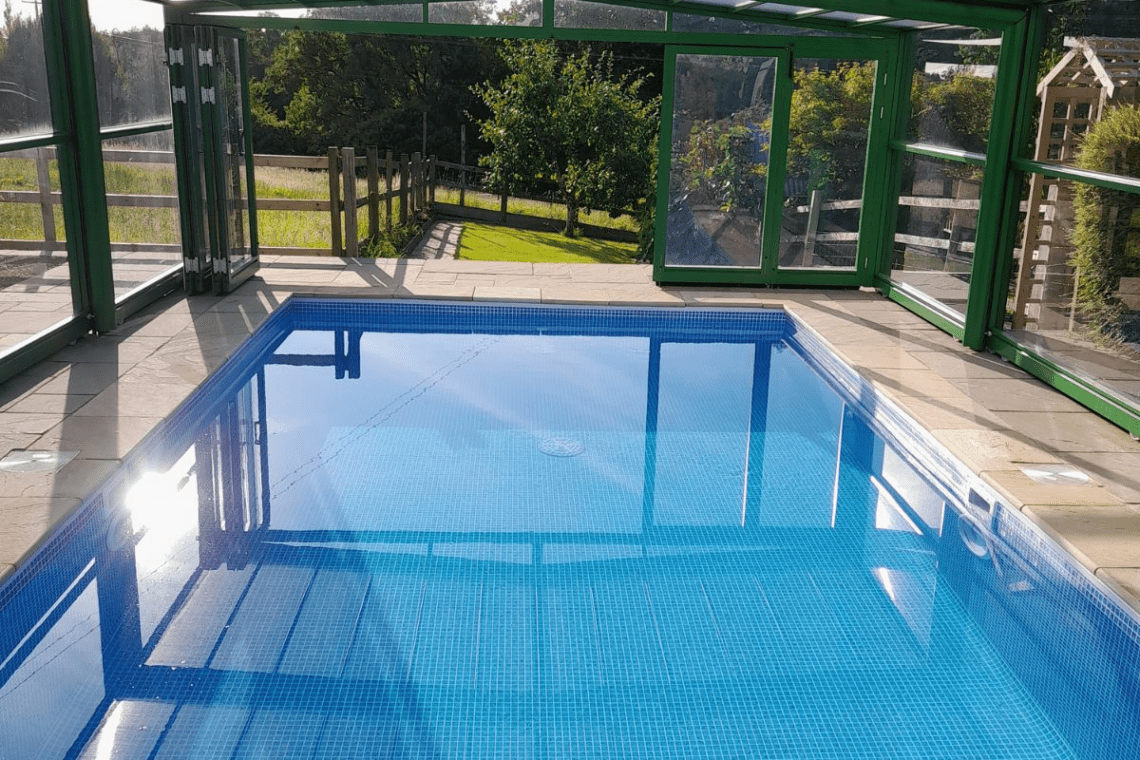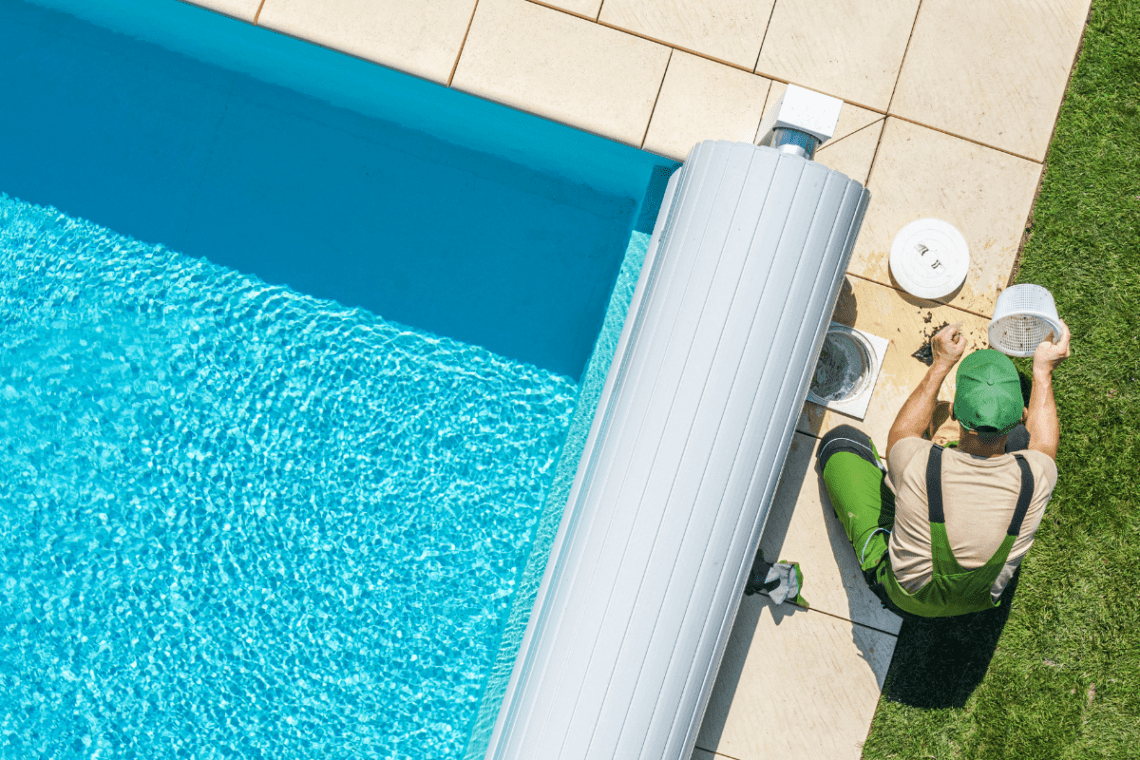Choosing between a swimming pond vs swimming pool can be a tough decision. Both have their own unique features. Your choice will depend on your preferences, lifestyle, and environmental considerations.
Let’s jump into the details and explore the differences, so you can make an informed decision.
Understanding the Basics
A swimming pond and a swimming pool might seem similar at first glance, but they are quite different in purpose and design.
Swimming Ponds

Swimming ponds, sometimes known as natural pools or natural swimming ponds, are designed to mimic the natural processes found in wild ponds and lakes. They typically feature a combination of shallow and deep areas, with the shallow zones housing a variety of aquatic plants. These plants are crucial, as they act as natural filters, keeping the water clear. The deep end is reserved for swimming, providing a natural and aesthetically pleasing swimming experience.
There are different types of swimming ponds, but the key feature is their natural filtration system and use of the Michael Wheat System. Unlike traditional pools that rely on chemical treatments, swimming ponds use plants and beneficial microorganisms to maintain water quality. The plants absorb nutrients that would otherwise promote algae growth, while microorganisms break down organic matter. This creates a balanced, self-sustaining ecosystem that requires minimal maintenance.
Swimming Pools

Swimming pools, on the other hand, are man-made structures specifically designed for swimming and recreational activities. They come in various shapes and sizes, from small above-ground pools to large in-ground installations. The design of a classic swimming pool is usually more geometric and artificial, aiming to provide a controlled and sanitary environment for swimming.
A traditional swimming pool relies on chemical treatments, primarily chlorine, to keep the water clean and free from bacteria and algae. These chemicals need to be regularly monitored and adjusted to ensure the water remains safe for swimming. The pool is also equipped with mechanical filtration systems, such as pumps and filters, to circulate and clean the water continuously.
Beauty and Aesthetics
Both a swimming pool and a swimming pond can significantly improve the aesthetic appeal of your garden or outdoor space. The choice between the two often comes down to personal preference, as they cater to different tastes and styles.
Swimming Ponds
- Natural Look: One of the most compelling features of a swimming pond is its ability to blend seamlessly with the natural landscape. Designed to mimic the appearance of natural bodies of water, swimming ponds often incorporate elements such as rocks, aquatic plants, and even small waterfalls. This design approach creates a serene and natural environment that feels like an extension of nature itself.
- Custom Design: Every swimming pond is unique, with custom design options allowing for a high degree of personalisation. You can choose specific plants, rock arrangements, and additional features such as lily pads or stepping stones. This level of customisation means your swimming pond can be tailored to reflect your personal taste and fit perfectly within the existing landscape of your garden.
Swimming Pools
- Artificial Look: Swimming pools, by contrast, have a more artificial appearance. Clean lines, geometric shapes, and smooth surfaces typically characterise them. This modern aesthetic can clash with natural surroundings, making pools stand out as distinctly man-made structures within a garden.
- Limited Customisation: While swimming pools offer some degree of customisation, primarily in terms of shape, size, and interior finishes, they lack the organic versatility of swimming ponds. Most pools follow a standard design template, focusing on functionality over natural integration.
Environmental Impact

When choosing between a swimming pond and a swimming pool, considering the environmental impact is crucial. Each option affects the environment differently, with swimming ponds typically being more eco-friendly. Here’s a closer look at the sustainability, resource use, and ecological balance of both.
Swimming Ponds
Swim ponds are the more sustainable and eco-friendly option. By choosing a swimming pond, you not only create a beautiful and natural swimming area but also make a positive contribution to the local ecosystem and reduce your environmental footprint.
- Eco-Friendly Filtration: Swimming ponds use plants and microorganisms for natural filtration, eliminating the need for chemical treatments. Aquatic plants like reeds and water lilies absorb nutrients that would otherwise promote algae growth, while microorganisms break down organic matter, keeping the water clear and clean.
- Biodiversity Support: Swimming ponds support diverse ecosystems, attracting insects, birds, and amphibians. This biodiversity enhances the pond’s beauty and promotes a healthier environment, creating a self-sustaining system where each organism helps maintain water quality.
- Reduced Chemical Use: A natural swimming pool avoids harmful chemicals like chlorine, reducing the risk of environmental contamination. This natural approach keeps the water safe for swimming without releasing pollutants into the environment.
- Lower Energy Consumption: Swimming ponds consume less energy compared to traditional pools. Their natural filtration process relies on biological activity rather than energy-intensive pumps and filters. When pumps are used, they are low-energy models, further reducing the carbon footprint.
Swimming Pools
- High Chemical Dependency: Traditional swimming pools rely heavily on chemicals like chlorine to maintain crystal clear water. These chemicals can harm the environment when they enter natural waterways, affecting aquatic life and ecosystems.
- Significant Energy Use: Swimming pools require continuous operation of pumps and filtration systems, consuming substantial energy. Pool heaters further increase energy use, leading to higher carbon emissions, especially if the electricity comes from non-renewable sources.
- Resource-Intensive Maintenance: Maintaining a swimming pool involves regular use of water, chemicals, and energy. Frequent top-ups, filter replacements, and chemical management contribute to a significant ecological footprint.
- Ecological Footprint: Traditional swimming pools contribute to a larger ecological footprint due to their resource-intensive nature and lack of support for local biodiversity. The production and disposal of pool materials contribute to environmental degradation.
Health Benefits

The health benefits of swimming ponds and swimming pools vary significantly due to their differences in design, maintenance, and the environment they create. Understanding these benefits can help you decide which option best aligns with your health priorities.
Natural vs. Artificial Environment
Swimming ponds provide a natural, chemical-free environment that can be more beneficial for overall health. The absence of chemicals reduces the risk of skin and eye irritation, and the natural surroundings promote mental well-being. Swimming pools, while offering a controlled environment, expose swimmers to chemicals that can cause various health issues over time.
Exercise and Physical Health
Both swimming ponds and swimming pools offer excellent opportunities for exercise, but the natural setting of a swimming pond can enhance the overall experience. The cooler water and natural resistance can invigorate the body and improve circulation, providing a holistic approach to fitness. Swimming pools offer a predictable environment for structured exercise, making them suitable for specific fitness routines and physiotherapy.
Stress and Mental Health
The natural beauty and tranquillity of swimming ponds provide a unique environment for stress reduction and mental relaxation. Being in nature can lower stress levels and enhance mental health. In contrast, swimming pools, while functional, lack the natural elements that contribute to a calming atmosphere.
Cost Comparison

When deciding between a swimming pond and a swimming pool, it’s essential to consider the financial implications of each option.
Long-Term Expenses
- Swimming Ponds: Swimming ponds have lower maintenance costs because the natural filtration system reduces the need for expensive chemicals.
- Swimming Pools: Maintaining a swimming pool requires chemical treatments, energy costs for filtration and heating systems, and occasional repairs.
Energy Consumption
- Swimming Ponds: Swimming ponds are energy-efficient, using natural processes for water filtration. Minimal pump usage results in lower utility bills and a smaller carbon footprint.
- Swimming Pools: Swimming pools, especially heated ones, significantly increase energy consumption. Maintaining water temperature and running filtration systems continuously can lead to high energy bills.
Durability and Longevity
- Swimming Ponds: With proper care, swimming ponds can last for several decades. The natural materials and systems enhance the pond’s ecosystem and value.
- Swimming Pools: Swimming pools are durable but require frequent maintenance. Liners or tiles may need replacing every 10-15 years, and filtration systems might need periodic upgrades.
Resale Value
- Swimming Ponds: A well-designed swimming pond can boost property value due to its unique, eco-friendly appeal. Buyers interested in sustainable living will find it particularly attractive.
- Swimming Pools: Swimming pools can also increase property value, especially in warmer climates. However, potential buyers might be wary of high maintenance costs and the commitment required for upkeep.
Maintenance Requirements

Understanding the maintenance requirements of a swimming pond versus a swimming pool is crucial for making an informed decision. Each option entails different upkeep tasks, costs, and time commitments.
Swimming Pond Upkeep
- Natural Filtration: Swimming ponds use natural methods to keep the water clean. Plants and microorganisms act as natural filters.
- Plant Maintenance: Regular work includes checking and managing the health of these plants. Trimming overgrowth and clearing dead foliage prevents algae growth.
- Filtration equipment: Including sponges and UV lightbulbs, should be cleaned regularly, and the bulbs replaced annually. While traditional swimming ponds may not incorporate these features, the system installed by Ponds by Michael Wheat goes above and beyond to ensure safe swimming water. This is because, unfortunately, plants alone cannot achieve the necessary level of water purification.
- Algae Control: Algae can be an issue, requiring manual removal or using a net. Pond water should be tested periodically to ensure the biological processes are balanced.
- Winter Care: In winter, it may be necessary to winterise your pond and remove or protect delicate plants from frost. Equipment like pumps and filters should be checked and maintained regularly.
Check out our expert pond maintenance packages and let us do the hard work for you.
Swimming Pool Maintenance
- Chemical Treatments: Pools rely on chemicals to maintain water quality. Chlorine and other chemicals keep the water safe and free from bacteria. It’s crucial to monitor and adjust chemical levels daily.
- Debris Removal: Outdoor pools need regular skimming to remove debris, leaves, and bugs. The pool floor and walls must be scrubbed to prevent algae formation.
- Equipment Maintenance: Filters and pumps require consistent cleaning and maintenance to ensure efficient operation. These should be checked weekly and replaced as needed.
- Winter Care: Winterising a pool involves covering it and adding antifreeze products to prevent damage from freezing temperatures.
Final Thoughts
In the battle of swimming ponds vs. swimming pools, swimming ponds stand out as a sustainable, beautiful, and health-friendly alternative. Their natural charm, environmental benefits, and long-term cost savings make them an enticing choice for those looking to create a serene retreat in their garden. If you value eco-friendliness, health benefits, and aesthetic appeal, a swimming pond might just be the perfect addition to your home.
At Ponds by Michael Wheat, we specialise in creating bespoke swimming ponds that blend seamlessly with your garden, offering you a unique and sustainable way to enjoy water in your outdoor space. Our expert team is dedicated to designing and building swimming ponds that are not only beautiful but also environmentally responsible.
Ready to Transform Your Garden?
Visit Ponds by Michael Wheat to explore our portfolio and learn more about our services. Contact us today for a consultation, and let’s create a beautiful, natural swimming experience right in your own garden!
Key Takeaways
- Swimming ponds offer a natural, eco-friendly experience.
- Swimming pools provide a structured and controlled environment.
- Maintenance methods differ greatly between these two options.
Related Posts:
- Swimming ponds : A Lifestyle Investment Not To Be Missed!
- Do Ponds Need Pumps: Essential Circulation Information for Healthy Water Features
- Can You Swim in a Pond: Our Definitive Guide
- 5 Top Reasons why Winter is the best time for a SwimPond
- Pond & SwimPond Maintenance Tips for Every Season
- Natural Pond Filtration: Expert Guide for a Crystal Clear Swim Pond